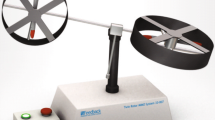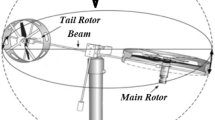Abstract
This study presents a nonlinear auto-regressive moving average (NARMA) based online learning controller algorithm providing adaptability, robustness and the closed loop system stability. Both the controller and the plant are identified by the proposed NARMA based input–output models of Wiener and Hammerstein types, respectively. In order to design the NARMA controller, not only the plant but also the closed loop system identification data are obtained from the controlled plant during the online supervised learning mode. The overall closed loop model parameters are determined in suitable parameter regions to provide Schur stability. The identification and controller parameters are calculated by minimizing the \(\varepsilon \)-insensitive error functions. The proposed controller performances are not only tested on two simulated models such as the quadrotor and twin rotor MIMO system (TRMS) models but also applied to the real TRMS with having severe cross-coupling effect between pitch and yaw. The tracking error performances of the proposed controller are observed better compared to the conventional adaptive and proportional–integral–derivative controllers in terms of the mean squared error, integral squared error and integral absolute error. The most noticeable superiority of the developed NARMA controller over its linear counterpart, namely the adaptive auto-regressive moving average (ARMA) controller, is observed on the TRMS such that the NARMA controller shows a good tracking performance not only for the simulated TRMS model but also the real TRMS. On the other hand, it is seen that the adaptive ARMA is incapable of producing feasible control inputs for the real TRMS whereas it works well for the simulated TRMS model.
























Similar content being viewed by others
References
Astrom KJ, Wittenmark B (1994) Adaptive control. Longman, Boston
Su X, Liu Z, Lai G (2018) Event-triggered robust adaptive control for uncertain nonlinear systems preceded by actuator dead-zone. Nonlinear Dyn 93(2):219–231
Baghbani F, Akbarzadeh-T MR, Akbarzadeh A, Ghaemi M (2016) Robust adaptive mixed h2/h\(\infty \) interval type-2 fuzzy control of nonlinear uncertain systems with minimal control effort. Eng Appl Artif Intell 49:88–102
Zhao Q, Xu H, Jagannathan S (2015) Neural network-based finite-horizon optimal control of uncertain affine nonlinear discrete-time systems. IEEE Trans Neural Netw Learn Syst 26(3):486–499
Battistelli G, Hespanha JP, Mosca E, Tesi P (2013) Model-free adaptive switching control of time-varying plants. IEEE Trans Autom Control 58(5):1208–1220
Ren Z, Fu W, Zhu S, Yan B, Yan J (2018) Bio-inspired neural adaptive control of a small unmanned aerial vehicle based on airflow sensors. Sensors 18(10):3233
Şahin S, Güzeliş C (2016) Online learning arma controllers with guaranteed closed-loop stability. IEEE Trans Neural Netw Learn Syst 27(11):2314–2326
Dydek ZT, Annaswamy AM, Lavretsky E (2013) Adaptive control of quadrotor UAVs: a design trade study with flight evaluations. IEEE Trans Control Syst Technol 21(4):1400–1406
Merheb AR, Noura H, Bateman F (2015) Design of passive fault-tolerant controllers of a quadrotor based on sliding mode theory. Int J Appl Math Comput Sci 25:561–576. https://doi.org/10.1515/amcs-2015-0042
Ma H, Liu Y, Li T, Yang G (2019) Nonlinear high-gain observer-based diagnosis and compensation for actuator and sensor faults in a quadrotor unmanned aerial vehicle. IEEE Trans Ind Inf 15(1):550–562
Rahideh A, Bajodah AH, Shaheed MH (2012) Real time adaptive nonlinear model inversion control of a twin rotor mimo system using neural networks. Eng Appl Artif Intell 25(6):1289–1297
Belmonte LM, Morales R, Fernández-Caballero A, Somolinos JA (2016) Robust decentralized nonlinear control for a twin rotor mimo system. Sensors 16(8):1160
Kavuran G, Ates A, Alagoz BB, Yeroglu C (2017) An experimental study on model reference adaptive control of TRMS by error-modified fractional order MIT rule. Control Eng Appl Inf 19(4):101–111
Tibshirani R (1996) Regression shrinkage and selection via the lasso. J R Stat Soc Ser B (Methodol) 58(1):267–288
Kukreja SL, Löfberg J, Brenner M (2006) A least absolute shrinkage and selection operator (lasso) for nonlinear system identification. IFAC Proc 39(1):814–819
Narendra KS, Parthasarathy K (1990) Identification and control of dynamical systems using neural networks. IEEE Trans Neural Netw 1(1):4–27
Cabrera JB, Narendra KS (1999) Issues in the application of neural networks for tracking based on inverse control. IEEE Trans Autom Control 44(11):2007–2027
Yesildirek A, Lewis FL (1994) Feedback linearization using neural networks. In: Proceedings of 1994 IEEE international conference on neural networks (ICNN’94). IEEE, vol 4, pp 2539–2544
Şahin S (2016) Learning feedback linearization using artificial neural networks. Neural Process Lett 44(3):625–637
Iplikci S (2006) Support vector machines-based generalized predictive control. Int J Robust Nonlinear Control IFAC Affil J 16(17):843–862
Şahin S, İşler Y, Güzeliş C (2010) A microcontroller based test platform for controller design. In: Proceedings of the IEEE international symposium on industrial electronics, Bari, Italy, pp 36–41
Feedback (n.d) Twin rotor mimo system control experiments. http://www.cpdee.ufmg.br/~palhares/33-942rotor.pdf. Accessed 11 Nov 2019
Smola A, Murata N, Scholkopf B (1998) Asymptotically optimal choice of epsilon-loss for support vector machines. In: International conference on artificial neural networks (ICANN). https://doi.org/10.1007/978-1-4471-1599-1_11
Boyd S, Mutapcic A (2008) Notes for EE364B, subgradient methods
Ogata K (2010) Modern control engineering. Prentice-Hall, Englewood Cliffs
Xia F, Sun YX (2008) Control and scheduling codesign: flexible resource management in real-time control systems. Springer, Berlin
Stowers J, Hayes M, Bainbridge-Smith A (2011) Altitude control of a quadrotor helicopter using depth map from microsoft kinect sensor. In: 2011 IEEE international conference on mechatronics. IEEE, pp 358–362
Min BC, Hong JH, Matson ET (2011) Adaptive robust control (ARC) for an altitude control of a quadrotor type uav carrying an unknown payloads. In: 2011 11th international conference on control, automation and systems. IEEE, pp 1147–1151
González I, Salazar S, Lozano R (2014) Chattering-free sliding mode altitude control for a quad-rotor aircraft: real-time application. J Intell Robot Syst 73(1–4):137–155
Lim JG, Jung S (2014) Altitude control of a quad-rotor system by using a time-delayed control method. J Inst Control Robot Syst 20(7):724–729
Muñoz F, González-Hernández I, Salazar S, Espinoza ES, Lozano R (2017) Second order sliding mode controllers for altitude control of a quadrotor UAS: real-time implementation in outdoor environments. Neurocomputing 233:61–71
Soydemir MU, Alkuş I, Bulucu P, Kocaoğlu A, Güzeliş C, Şahin S (2018) Data dependent stable robust adaptive controller design for altitude control of quadrotor model. In: 18th international conference on mechatronics—mechatronika (ME), mechatronika
Merheb AR (2011) https://www.mathworks.com/matlabcentral/fileexchange/40052-pd-control-of-quadrotor. Accessed 11 Nov 2019
Feedback (n.d) Twin rotor mimo system, advanced teaching manual 1. http://doc.es.aau.dk/fileadmin/doc.kom.aau.dk/labs_facillities/control/manuals/330074M5.pdf. Accessed 11 Nov 2019
Author information
Authors and Affiliations
Corresponding author
Ethics declarations
Conflict of interest
The authors declare that they have no conflict of interest.
Additional information
Publisher's Note
Springer Nature remains neutral with regard to jurisdictional claims in published maps and institutional affiliations.
This work was supported by the Scientific and Technological Research Council of Turkey (TÜBİTAK) under Grant 116E170.
Rights and permissions
About this article
Cite this article
Bulucu, P., Soydemir, M.U., Şahin, S. et al. Learning Stable Robust Adaptive NARMA Controller for UAV and Its Application to Twin Rotor MIMO Systems. Neural Process Lett 52, 353–383 (2020). https://doi.org/10.1007/s11063-020-10265-0
Published:
Issue Date:
DOI: https://doi.org/10.1007/s11063-020-10265-0




